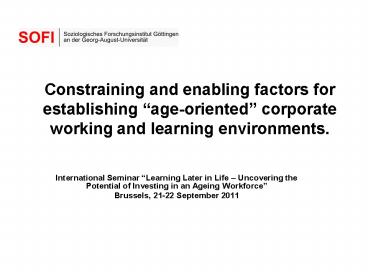Constraining and enabling factors for establishing - PowerPoint PPT Presentation
1 / 18
Title:
Constraining and enabling factors for establishing
Description:
Constraining and enabling factors for establishing age-oriented corporate working and learning environments. International Seminar Learning Later in Life ... – PowerPoint PPT presentation
Number of Views:129
Avg rating:3.0/5.0
Title: Constraining and enabling factors for establishing
1
Constraining and enabling factors for
establishing age-oriented corporate working and
learning environments.
- International Seminar Learning Later in Life
Uncovering the Potential of Investing in an
Ageing Workforce - Brussels, 21-22 September 2011
2
- Background
- Considerable gap between scientific, political
and public discourse and corporate reality - Intensified debate (increased retirement age
lack of skilled personnel) - Large amount of literature, policy
recommendations and examples of good practice - Elements of Age Management well established
- Continuous learning is integral part
- However by-and-large limited impact on corporate
HR and labour policies
3
- Explaining the gap
- What are barriers?
- What are enabling conditions?
- Search direction
- Role of context on the industry- and firm-level
- Microeconomics
- Institutions (part. collective agreements)
4
- Methodology
- Standardized online/CATI-survey
(11/2009-02/2010) - 474 corporate managers (general
managers/personell managers) - 311 works councillors
- 11 short case-studies
- 42 interviews (between 1 and 2 hrs) in selected
companies - 12 interviews with representatives of employer
associations and trade unions - Industry-specific data of other sources
- IAB-establishment panels
- CVTS3-additional survey of BiBB
- BiBB/BAuA employee survey
5
Age structures in ME, ChPh, Retailing 2009
Source Federal Labour Agency 2010 (reference
date 30.06.2009). with social insurance
6
Perceived impact of demographic changes
7
Top 3 ranking problems of older employees (50)
8
Dissemination of measures for older employees
(50)
9
- Measures for 50
10
Dissemination of measures for all employees
11
- Constraints I
- Micro-economics
- age-oriented working and learning conditions as
a carried-off utopia (Reindl 2009) in
finance-driven capitalism? - Age-orientation costs money now, but pays off
only in the future - Significant correlation firms that
expect/anticipate negative impact of demographic
changes offer more measures - Undoubtedly, the economic crisis sets other
priorities - Majority of companies affected by crisis stated
that demographic challenge is no longer a
priority issue
12
- Constraints II
- Information I lack of relevant knowledge
Significant correlation firms that analyse their
age structure have more measures.
13
- Constraints II
- Information II lack of relevant knowledge
14
- Constraints III
- Institutionalization of early retirement
- Became almost biographical norm in many
industries with - a tradition in physically demanding working
conditions (like Chemicals, Metalwork, Steel) - strong industrial relations (like ChPh, ME and
Public Services) - severe structural changes (downsizing,
outsourcing, new technologies) - Capital and Labour were able to deal with
pressures and socio-economic changes - Costs were socialized
- Government could attenuate labour market problems
- Backdrop little incentives for companies,
unions/works councils to change working and
learning conditions
15
- Enabling factors
- Economics
- Make costs quantifiable
- Step-by-step approach instead of grand design
- Information and assistance
- Firms that use tools (age analysis) show higher
level of activity - Trade unions and employer associations are
important facilitators - Firms that integrate their employees show better
results
16
- Enabling factors
- Institutional regime
- Collective/general agreements
- Since end of the 1990s numerous agreements
adressing continous training - No generalizable model
- Most frequent soft regulations processes to
determine demand and to develop training
strategy/planning (i.e. no entitlement to receive
training) - Contested terrain
- Employers see managerial prerogative threatened
interested in shifting financial/time burden on
employees - Works councils critizise soft character topic
not high on their agenda - Limited effects breadthwise (no significant
increase of investments into training
selectivity of training access not reduced
Bahnmüller 2009)
17
- Enabling factors
- Institutional regime
- Lately new agreements adressing demographic
change in the Steel Industry (2006) and in
Chemicals (2008) - Comprehensive appoach (working time, work
organization, work-life-balance,
health-issues/ergonomics, continous training) - Mandatory age structure/qualification analysis
discussion with works councils about consequences - Endowment fund (300 per year/employee) (not for
training) mostly put into existing pension funds - Preliminary results
- mandatory tools brought issue of ageing into the
firms - Agreement legitimizes reform oriented actors in
HR and works councils - Corporate actors need assistance
18
- Conclusion
- Urgency to deal with demographic change is not
very high today, but increasing pressure in the
future - Context Industry- and firm-specific problems
- Different actor perspectives
- Still almost no measures for older employees
- Some measures that can be helpful for all age
groups, but little innovation - Major constraints are economic, informational and
institutional in nature - Tension between necessary strategic shift towards
better working and learning conditions for all
employees and the need to provide
early-exit-options for the 50 - Mandatory age/qualification analysis on the firm
level? - Legal entitlement for continous training?































